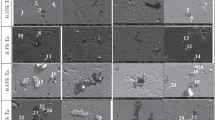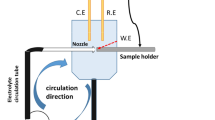Abstract
The influence of the zirconium diboride content and the method of initial material preparation on the corrosion properties of the composite on the 316L stainless steel matrix were determined. The powders were prepared in a Turbula mixer and a planetary mill. The corrosion properties were estimated on the basis of electrochemical tests, including open-circuit potential measurement, potentiodynamic polarization, and electrochemical impedance spectroscopy. The presence of the ceramic phase changes the corrosion resistance of the tested materials due to porosity, which affects the corrosion mechanism. The standard potentiodynamic tests do not reveal poor corrosion resistance of porous materials, and only 24 h tests reveal accurate corrosion resistance of composite materials. Composites cannot go into a stable passive state because of the penetration of electrolytes into the pores and tend to oxidize systematically. 24-h corrosion tests indicate that samples prepared in a planetary mill show better corrosion resistance than those prepared in a Turbula mixer.





Similar content being viewed by others
Data availability statement
The data that support the findings of this study are available from the corresponding author upon reasonable request. Data sharing is not applicable to this article, as no datasets were generated or analyzed during the current study.
References
Grasso S, Sakka Y, Maizza G. Electric current activated/assisted sintering (ECAS): a review of patents 1906–2008. Sci Technol Adv Mater. 2009;10:53001. https://doi.org/10.1088/1468-6996/10/5/053001.
Tokita M. Trends in advanced SPS spark plasma sintering systems and technology. J Soc Powder Technol Jpn. 1993;30:790–804. https://doi.org/10.4164/sptj.30.11_790.
Guillon O, Gonzalez-Julian J, Dargatz B, Kessel T, Schierning G, Räthel J, Herrmann M. Field-assisted sintering technology/spark plasma sintering: mechanisms, materials, and technology developments. Adv Eng Mater. 2014;16:830–49. https://doi.org/10.1002/adem.201300409.
Munir ZA, Anselmi-Tamburini U, Ohyanagi M. The effect of electric field and pressure on the synthesis and consolidation of materials: a review of the spark plasma sintering method. J Mater Sci. 2006;41:763–77. https://doi.org/10.1007/s10853-006-6555-2.
Omori M. Sintering, consolidation, reaction and crystal growth by the spark plasma system (SPS). Mater Sci Eng A. 2000;287:183–8. https://doi.org/10.1016/s0921-5093(00)00773-5.
Guo SQ. Densification of ZrB2-based composites and their mechanical and physical properties: a review. J Eur Ceram Soc. 2009;29:995–1011. https://doi.org/10.1016/j.jeurceramsoc.2008.11.008.
Fahrenholtz WG, Hilmas GE, Talmy IG, Zaykoski JA. Refractory diborides of zirconium and hafnium. J Am Ceram Soc. 2007;90:1347–64. https://doi.org/10.1111/j.1551-2916.2007.01583.x.
Bansal NP. Handbook of ceramic composites. Boston: Kluwer Academic Publishers; 2005.
Morz C. Zirconium diboride. Am Ceram Soc Bull. 1995;74:164–5.
Asadipanah Z, Rajabi M. Production of Al–ZrB2 nano-composites by microwave sintering process. J Mater Sci Mater Electron. 2015;26:6148–56. https://doi.org/10.1007/s10854-015-3195-9.
Nallusamy M, Sundaram S, Kalaiselvan K. Fabrication, characterization and analysis of improvements in mechanical properties of AA7075/ZrB2 in-situ composites. Measurement. 2019;136:356–66. https://doi.org/10.1016/j.measurement.2018.12.110.
Wang C, Lin H, Zhang Z, Li W. Fabrication, interfacial characteristics and strengthening mechanisms of ZrB2 microparticles reinforced Cu composites prepared by hot-pressed sintering. J Alloys Compd. 2018;748:546–52. https://doi.org/10.1016/j.jallcom.2018.03.169.
Ghasali E, Pakseresht A, Safari-kooshali F, Agheli M, Ebadzadeh T. Investigation on microstructure and mechanical behavior of Al-ZrB2 composite prepared by microwave and spark plasma sintering. Mater Sci Eng A. 2015;627:27–30. https://doi.org/10.1016/j.msea.2014.12.096.
Kaku SMY, Khanra AK, Davidson MJ. Effect of deformation on properties of Al/Al-alloy ZrB2 powder metallurgy composite. J Alloys Compd. 2018;747:666–75. https://doi.org/10.1016/j.jallcom.2018.03.088.
Sulima I, Hyjek P, Jaworska L, Perek-Nowak M. Influence of ZrB2 on microstructure and properties of steel matrix composites prepared by spark plasma sintering. Materials. 2020. https://doi.org/10.3390/ma13112459.
Dinaharan I, Murugan N, Parameswaran S. Influence of in situ formed ZrB2 particles on microstructure and mechanical properties of AA6061 metal matrix composites. Mater Sci Eng A. 2011;528:5733–40. https://doi.org/10.1016/j.msea.2011.04.033.
Sulima I, Putyra P, Hyjek P, Tokarski T. Effect of SPS parameters on densification and properties of steel matrix composites. Adv Powder Technol. 2015. https://doi.org/10.1016/j.apt.2015.05.010.
Akhtar F, Feng P, Du X, Jawid AS, Tian J, Guo S. Microstructure and property evolution during the sintering of stainless steel alloy with Si3N4. Mater Sci Eng A. 2008;472:324–31. https://doi.org/10.1016/j.msea.2007.04.032.
Tjong SC, Lau KC. Abrasion resistance of stainless-steel composites reinforced with hard TiB2 particles. Compos Sci Technol. 2000. https://doi.org/10.1016/s0266-3538(00)00008-7.
Sedriks AJ. Corrosion of stainless steels. New York: Wiley; 1996.
Menapace C, Molinari A, Kazior J, Pieczonka T. Surface self-densification in boron alloyed austenitic stainless steel and its effect on corrosion and impact resistance. Powder Metall. 2013;50:326–35. https://doi.org/10.1179/174329007X205028.
Deflorian F, Ciaghi L, Kazior J. Electrochemical characterization of vacuum sintered copper alloyed austenitic stainless steel. Mater Corros. 1992;43:447–52. https://doi.org/10.1002/MACO.19920430907.
Itzhak D, Harush S. The effect of Sn addition on the corrosion behaviour of sintered stainless steel in H2SO4. Corros Sci. 1985;25:883–8. https://doi.org/10.1016/0010-938X(85)90018-6.
Angelini E, Bianco P, Rosalbino F, Rosso M, Scavino G. Sintered austenitic stainless steels: corrosion behaviour in sulphate and chloride media. Mater Corros. 1994;45:392–401. https://doi.org/10.1002/MACO.19940450705.
German RM. Sintering theory and practice. New York: Wiley; 1996.
Kang S-JL. Sintering: densification, grain growth, and microstructure. Amsterdam: Elsevier; 2008.
Raja Annamalai A, Upadhyaya A, Agrawal DK. Effect of heating mode and Y2O3 addition on electrochemical response on austenitic and ferritic stainless steels. Corros Eng Sci Technol. 2015;50:91–102. https://doi.org/10.1179/1743278214Y.0000000176.
Padmavathi C, Upadhyaya A, Agrawal D. Corrosion behavior of microwave-sintered austenitic stainless steel composites. Scr Mater. 2007. https://doi.org/10.1016/j.scriptamat.2007.06.007.
Patel M. Corrosion behaviour of sintered 316l austenitic stainless steel composites, (n.d.). https://www.academia.edu/19239819/CORROSION_BEHAVIOUR_OF_SINTERED_316L_AUSTENITIC_STAINLESS_STEEL_COMPOSITES. Accessed 1 July 2021.
Jaworska L, Skrzekut T, Stępień M, Pałka P, Boczkal G, Zwoliński A, Noga P, Podsiadło M, Wnuk R, Ostachowski P. The pressure compaction of Zr–Nb powder mixtures and selected properties of sintered and KOBO-extruded Zr–xNb materials. Materials (Basel). 2021. https://doi.org/10.3390/MA14123172.
Geenen K, Röttger A, Theisen W. Corrosion behavior of 316L austenitic steel processed by selective laser melting, hot-isostatic pressing, and casting. Mater Corros. 2017;68:764–75. https://doi.org/10.1002/maco.201609210.
Itzhak D, Aghion E. Corrosion behaviour of hot-pressed austenitic stainless steel in H2SO4 solutions at room temperature. Corros Sci. 1983. https://doi.org/10.1016/0010-938X(83)90090-2.
Fredriksson W, Petrini D, Edström K, Björefors F, Nyholm L. Corrosion resistances and passivation of powder metallurgical and conventionally cast 316L and 2205 stainless steels. Corros Sci. 2013;67:268–80. https://doi.org/10.1016/j.corsci.2012.10.021.
Maocheng YAN, Jin XU, Libao YU, Tangqing WU, Cheng SUN, Wei KE. EIS analysis on stress corrosion initiation of pipeline steel under disbonded coating in near-neutral pH simulated soil electrolyte. Corros Sci. 2016;110:23–34. https://doi.org/10.1016/j.corsci.2016.04.006.
Orazem ME, Tribollet B. Electrochemical impedance spectroscopy. 2nd ed. Hoboken: Wiley; 2017.
Rocha AMF, Bastos AC, Cardoso JP, Rodrigues F, Fernandes CM, Soares E, Sacramento J, Senos AMR, Ferreira MGS. Corrosion behaviour of WC hardmetals with nickel-based binders. Corros Sci. 2019;147:384–93. https://doi.org/10.1016/j.corsci.2018.11.015.
Kandala SR, Balani K, Upadhyaya A. Mechanical and electrochemical characterization of supersolidus sintered austenitic stainless steel (316 L). High Temp Mater Process (Lond). 2019;38:792–805. https://doi.org/10.1515/HTMP-2019-0032/MACHINEREADABLECITATION/RIS.
Sulima I, Hyjek P, Podsiadło M. Fabrication of the zirconium diboride-reinforced composites by a combination of planetary ball milling, turbula mixing and spark plasma sintering. Materials. 2021. https://doi.org/10.3390/ma14144056.
Acknowledgements
This work was supported by the Pedagogical University in Krakow, Poland, within the research project WPBU/2020/05/00128.
Author information
Authors and Affiliations
Corresponding author
Ethics declarations
Conflict of interest
The authors declare no financial or commercial conflict of interest.
Additional information
Publisher's Note
Springer Nature remains neutral with regard to jurisdictional claims in published maps and institutional affiliations.
Supplementary Information
Below is the link to the electronic supplementary material.
Rights and permissions
About this article
Cite this article
Stępień, M., Sulima, I., Hyjek, P. et al. Evaluation of the corrosion resistance of spark plasma sintered stainless steel 316L matrix composites with zirconium diboride in sulfuric acid. Archiv.Civ.Mech.Eng 22, 127 (2022). https://doi.org/10.1007/s43452-022-00453-1
Received:
Revised:
Accepted:
Published:
DOI: https://doi.org/10.1007/s43452-022-00453-1




